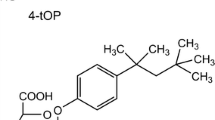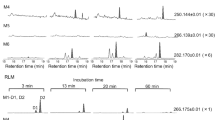Abstract
In acute oral studies, the effect of bromobenzene on hepatic microsomal enzymes was investigated. Neither glucuronyltransferases nor cytochrome c reductase showed significant changes. Most of the mixed-function oxidases studied were inhibited with the exception of ketamine-N-demethylase. The data indicate that bromobenzene or its epoxide acts on cytochrome P-450 but not on all cytochrome P-450 species, and does not affect the reductase and the glucuronyltransferases. Microsomal lipoperoxidation and microsomal H2O2 formation were increased.
Similar content being viewed by others
References
Baumann, E., Preusse, C.: Über Bromphenylmercaptursäure. Ber. Dtsch. Chem. Ges. 12, 806 (1879)
Belpaire, F. M.: Metabolism of papaverine. III. Effects of phenobarbital, 3-methylcholanthrene, and SKF 525 pretreatment in vivo and in vitro. Xenobiotica 5, 431–438 (1975)
Beyhl, F. E.: Biochemische und toxikologische Aspekte der Induktion arzneimittelmetabolisierender Enzyme. AMI-Berichte (Institut für Arzneimittel des Bundesgesundheitsamtes). (In press, 1980)
Beyhl, F. E., Lindner, E.: Diphasic action of the aliphatic amide, Hoe 17879, on hepatic microsomal drug metabolizing enzymes in the mouse. Experientia 32, 362–365 (1976)
Beyhl, F. E., Sinharay, A.: Use of methylayapanine as a substrate for microsomal O-demethylase. 4th Internat. Symp. on Microsomes and Drug Oxidations, Ann Arbor, R 105, 1979
Bridges, J.W., Creaven, P.J., Williams, R.T.: The fluorescence of some biphenyl derivatives. Biochem. J. 96, 872–878 (1965)
Brodie, B. B., Reid, W., Cho, A. K., Sipes, G., Krishna, G., Gillette, J. R.: Possible mechanism of liver necrosis caused by aromatic organic compounds. Proc. Natl. Acad. Sci. USA 68, 160–164 (1971)
Cleveland, P. D., Smuckler, E. A.: Effect of CCl4, dimethylnitrosamine, and thioacetamide on hepatic DPNH and TPNH cytochrome c reductases. Proc. Soc. Exp. Biol. Med. 120, 808–810 (1965)
Dallner, G.: Studies on the structural and enzymic organization of the membraneous elements of liver microsomes. Acta Pathol. Microbiol, Scand. [Suppl.] 166, 25 (1963)
Davies, W. H., Creaven, P. J.: The effect of carcinogenic and noncarcinogenic compounds on the O-dealkylating activity of the hepatic microsomal enzyme system of the rat. Biochem. Pharmacol. 16, 1839–1845 (1964)
Dunnett, C. W.: A multiple comparison procedure for comparing several treatments with control. J. Am. Statist. Assoc. 50, 1096–1121 (1955)
Fisher, R. A.: In: Angewandte Statistik, 5. Aufl. Sachs, L. (Hrsg.), S. 288. Berlin, Heidelberg, New York: Springer 1978
Gustafsson, J.-Å., Ingelman-Sundberg, M.: Multiple forms of cytochrome P-450 in rat liver microsomes. Separation and some properties of different hydroxylases active on free and sulphoconjugated steroids. Eur. J. Biochem. 64, 35–43 (1976)
Hammar, C.-H., Gempp-Friedrich, F.: Glucuronyltransferasen des Meerschweinchens bei experimenteller Hepatopathie infolge Langzeitbehandlung mit Thioacetamid. Res. Exp. Med. 160, 112–121 (1973)
Haugen, D. A., Vanderhoeven, A., Coon, M. J.: Purified liver microsomal cytochrome P-450. Separation and characterization of multiple forms. J. Biol. Chem. 250, 3567 (1975)
Heni, N., Remmer, H.: Die Wirkung von Tetrachlorkohlenstoff auf endoplasmatische Enzyme der Rattenleber. Arch. Toxicol. 28, 1–11 (1971)
Hildebrandt, A. G., Speck, M., Roots, I.: Possible control of hydrogen peroxide production and degradation in microsomes during mixed-function oxidation reaction. Biochem. Biophys. Res. Commun. 54, 968–975 (1973)
Jaffeè, M.: Über die nach Einführung von Brombenzol und Chlorbenzol im Organismus entstehenden schwefelhaltigen Säuren. Ber. Dtsch. Chem. Ges. 12, 1092–1098 (1879)
Jollow, D. J., Mitchell, J. R., Zampaglione, N., Gillette, J. R.: Bromobenzene-induced liver necrosis. Protective role of glutathione and evidence for 3,4-bromobenzene oxide as the hepatic metabolite. Pharmacology 11, 151–169 (1974)
Kamath, S. A., Rubin, E.: Interaction of calcium with microsomes: A modified method for the rapid isolation of rat liver microsomes. Biochem. Biophys. Res. Commun. 49, 52–59 (1972)
Kappus, H., Zentner, J.: Protective effects of (+)-cyanidanol-3 against CCl4-induced hepatotoxicity. SOT 18th Ann. Meeting, New Orleans, LA. R 218, 1979
Kupfer, D., Levin, E.: Monooxigenase drug metabolizing activity in CaCl2 aggregated hepatic microsomes from rat liver. Biochem. Biophys. Res. Commun. 47, 611–618 (1972)
Levene, H.: In: Statistische Auswertungsmethoden, 3. Aufl. Sachs, L. (Hrsg.), S. 207. Berlin, Heidelberg, New York: Springer 1971
Nemenyi, P.: In: Statistische Auswertungsmethoden, 5. Aufl. Sachs, L. (Hrsg.), S. 420. Berlin, Heidelberg, New York: Springer 1978
Parkki, M. G.: Effects of silymarin on CCl4, paracetamol, and bromobenzene caused deterioration on detoxifying enzymes. Acta Physiol. Scand. [Suppl.] 440, 139 (1976)
Potter, V. R., Elvehjem, C. A.: A modified method for the study of tissue oxidation. J. Biol. Chem. 114, 495 (1936)
Recknagel, R. O., Ghoshal, A. K.: Lipoperoxidation as a vector in carbon tetrachloride hepatotoxicity. Lab. Invest. 15, 132–148 (1966)
Reid, W. D., Krishna, G., Gillette, J. R., Brodie, B.: Biochemical mechanism of hepatic necrosis induced by aromatic hydrocarbons. Pharmacology 10, 193–214 (1973)
Schenkman, J. B., Cinti, D. L.: Hepatic mixed function oxidase activity in rapidly prepared microsomes. Life Sci. 11, 247–257 (1972)
Strubelt, O., Völpel, M.: On the development of tolerance to hepatotoxic agents. Naunyn-Schmiedebergs Arch. Pharmacol. 302, R 19 (1978)
Ullrich, V., Weber, P.: The O-dealkylation of 7-ethoxycoumarin by liver microsomes. A direct fluorometric test. Hoppe-Seylers Z. Physiol. Chem. 353, 1171–1177 (1972)
Wendel, A., Feuerstein, S., Konz, K.-H.: Acute paracetamol intoxication of starved mice leads to lipid peroxidation in vivo. Biochem. Biopharmacol. 28, 2051–2055 (1979)
Williams, R. T.: Detoxication mechanisms, p. 237. London: Chapman and Hall 1959
Zampaglione, N., Jollow, D. J., Mitchell, J. R., Stripp, B., Hamrick, M., Gillette, J. R.: Role of detoxifying enzymes in bromobenzene-induced liver necrosis. J. Pharmacol. Exp. Ther. 187, 218–227 (1973)
Author information
Authors and Affiliations
Additional information
Dedicated to Prof. R. Sammet on occasion of his 60th birthday
Rights and permissions
About this article
Cite this article
Beyhl, F.E., Mayer, D.G. Studies on liver toxicants. Arch. Toxicol. 43, 257–262 (1980). https://doi.org/10.1007/BF00366181
Received:
Issue Date:
DOI: https://doi.org/10.1007/BF00366181




